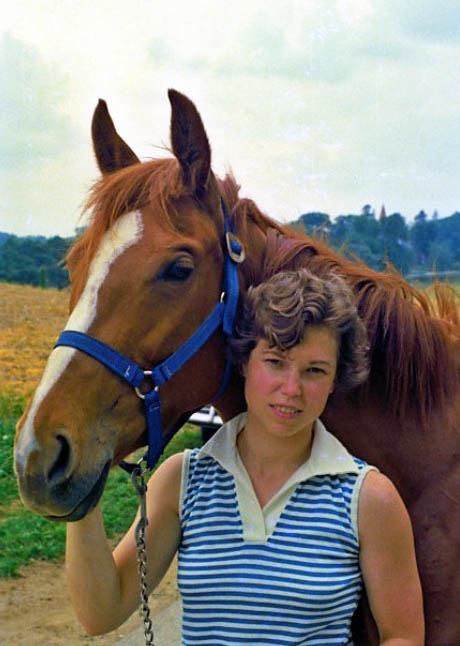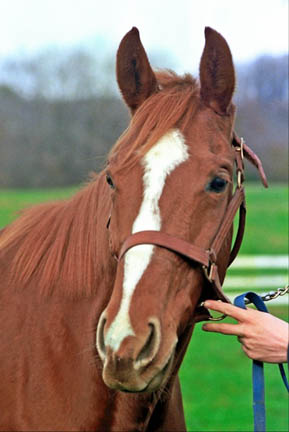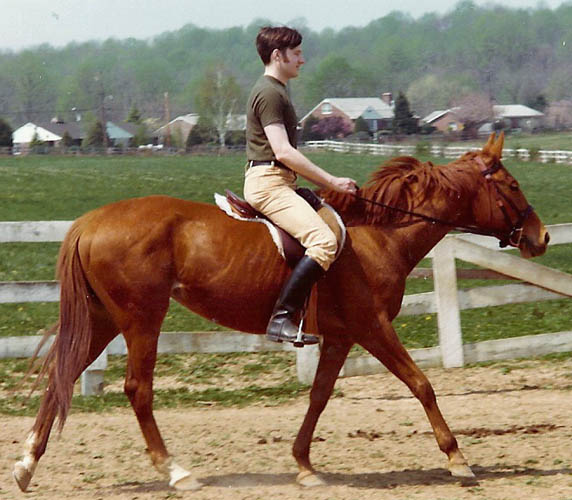My Wife and the Chestnut Mare
They were a pair.


|
My first introduction to this chestnut mare was not auspicious and resulted in my feet being stepped on not once, but twice. It was the beginning of my education of how to dance under a horse’s hooves. My wife was determined to teach me to ride, and I was more than a little nervous at the prospect. I realize now in retrospect that we should have had me take lessons from a professional on a nice quiet school horse and not this hyper Thoroughbred that we had, but that is not what happened. If you are not a rider and want to learn, you can profit by my mistake. However, I think that I would not go back and change anything if I had it to do over again. I can only smile at the often stupid things I did and thank God that I did not come to any harm.
I remember very clearly the first time I got on the chestnut mare. “What do I do now?” I heard myself say in a voice that was maybe a little higher pitched than I would have liked. “Squeeze her with your legs,” came the instruction. Nothing at all happened except that a large chestnut horse head arched around and looked back at me. She raised her lip just a little and showed some teeth in what I easily understood as a sneer. It was clear to me, at least, that she was saying, “And just what do YOU think you are doing up there.” When I got no response, I said “What do I do now?” “Squeeze her harder with your legs,” the instruction came. Nothing happened and the chestnut began to paw the ground, first with one hoof and then the other. My wife finally had had enough of this and gave the chestnut a crack on her chest with a crop. It was like someone had thrown a switch. The horse squared herself and began to move forward at a walk as perfectly as if we were in a show ring. The mare knew that she could push me around, but my wife was an entirely different story. When my wife would get mad at the chestnut, the mare’s eyes would get as big as saucers and she would shrink back. I remember looking at my wife in amazement and thinking that that huge animal is absolutely terrorized of her when she is mad. Even more amazing to me was that my wife did not show even the slightest fear when correcting this massive beast. It was one of those moments in which a husband realizes exactly who he is married to, and in this case just what a true horsewoman is, but that is the meat of another discussion and back to my story of learning to ride.

|
Most horses have four basic gaits or ways of moving. The slowest is the walk which is fairly easy for a beginner to pick up. The next gait is the trot, which is twice as fast. Posting to a trot is a fairly new development that was perfected in England with the post coaches. They wanted to make good time and needed to travel faster than a walk, but a horse running down a road quickly exhausts itself and constitutes a hazard to other travelers. The answer was to have the team trot, but there was a problem with doing that. The coaches were better controlled by riders mounted on half of the team, but few people can sit to a trot for a long period of time. The answer proved to be having the men post. This is a rhythmic standing and sitting while trotting that proved much easier on both the horse and rider.
Up, down, up, down, just how long can this go on? Up, down, up, down, I could see that my wife was getting impatient with her slow learning student. I have no sense of rhythm. Will I ever learn to post? I kept trying and the poor chestnut mare persisted in that patient, long suffering way animals have done for generations. Suddenly when I least expected it, there it was. I thought that I would never learn, but there I was, posting to the trot. I have worked with other people who picked it up in no time. Silke K was one of them. She was a girl visiting from Austria who loved horses. When I worked with her she learned how to post almost immediately, but I was not nearly so gifted. For me it was a supreme struggle, but once I got it, I had it forever. There is a certain security in knowing one speed greater than the one you are riding in. If you know only how to sit on a horse at a walk, there is nowhere else to go but down to the ground when the horse is spooked and breaks into a faster gait. On the other hand, if you can trot and the animal suddenly accelerates, you have the time to pull him back down to a walk. My confidence got a boost, but I was not finished yet.

|
At this point I could manage a walk, trot and canter, but there was another major thing to learn: jumping. A lot of people seem surprised that I would jump a horse. Well, it happens at times that you need to jump, and if so, you better know how to do it. A horse is truly nature’s all terrain vehicle and on the trail you often must jump logs or ditches. At this point in time we moved the chestnut mare to a new stable that was located at a private school. It was once a military school and had a well-equipped indoor riding facility that also accepted boarders who were not associated with the school. They owned a large amount of undeveloped woodland through which were miles of riding trails. Lastly, they had a staff of riding instructors, occasional clinics, and group trips to horse shows. It was a totally new scene and I soon experienced the camaraderie that exists among horse people. My wife decided that I would benefit from lessons and I got as an instructor, Beth C. She was the perfect instructor for the beginner. She was friendly, patient, and encouraging. Beth’s job was to teach me to jump and she would not take no for an answer. She suggested that I let the reins go limp and hold onto the horse’s mane over the jump. It worked! We jumped. Maybe not the best form, but we did it.
I soon built up experience and confidence and now I look absolutely blasé on horseback. I should also mention that in time, and despite our rocky start, the chestnut mare and I became the best of friends. I often think that I was a much better rider when I was taking lessons and applying myself. I see people doing dressage or other demanding forms of riding and think to myself, should I take lessons again? Should I push myself to grow and learn as a rider? However, I am reminded of what Jane Smiley wrote in her book “A Year at the Races.” She points out that it is very hard after so many years to find yourself a student again, to submerge your adult ego and have someone else pointing out your failings and shortcomings. She wisely and correctly points out that your shortcomings as a rider are only too often also your shortcomings as a person in general. Thinking about it, she is absolutely correct in this insight. I think taking lessons again would be a good thing, but my wife suggests that at this point in our lives why not just accept ourselves for the riders we are and just enjoy being on our horses, and that sounds good to me because I am after all only….